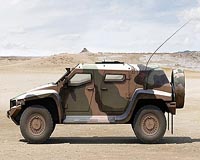| . |  |
. |
Tel Aviv, Israel (UPI) Nov 30, 2009 Israel is sticking to its guns on a demand the United States allow it to integrate its own electronic warfare suite in Lockheed Martin's F-35 Joint Strike Fighter, even though the Americans have given the green light to install other Israeli systems in the jet. Israel wants to buy an initial batch of 25 F-35s, enough for one squadron, in fiscal 2012 and would like to acquire another 50. The U.S. Department of Defense and Maryland-based Lockheed Martin, the prime contractor in the program, want to finalize a contract with Israel as soon as possible. The main holdup has been the Israelis' insistence on installing their own systems -- including communications and radar -- as well as weapons aboard the F-35, as they were allowed to do with the Boeing F-15 and Lockheed Martin F-16 aircraft they have bought from the United States over the last two decades. The Americans have been reluctant to allow that because it would compromise ultra-sensitive software codes. But a senior Pentagon official disclosed last Wednesday that the Israelis could install most of the systems they want provided they finalize a deal in the next few months. But the official, Jon Schreiber, who heads the F-35 international program, insisted that the Israelis' electronic warfare suite, the core of their demand, could not be included -- not now, at any rate. "Some time in the future, if policy changes, or things change, that could change as well," he said. Other partner countries in the JSF program, such as Britain, have requested the software codes for operational sovereignty and have also been turned down. In 2006 the United Kingdom threatened to scrap plans to buy 138 of the radar-evading aircraft if it was not able to maintain and upgrade its fleet without U.S. involvement. That dispute was settled later that year, with the United Kingdom given operational sovereignty. Britain committed $2.7 billion to develop the F-35. That was more than any other of the United States' partners in the project, which include Turkey, Canada, the Netherlands and Norway. Another partner, Australia, last week approved the acquisition of 14 F-25s at an estimated cost of $2.96 billion. The first squadron should be operational by 2018, with two more squadrons -- 72 aircraft all told -- ready by 2021. Lockheed Martin expects to sell up to 4,500 F-35s worldwide, with the United States spending around $410 billion over the next quarter-century to buy 2,443 F-35 variants, its costliest arms acquisitions ever. The Jerusalem Post has reported that the Israelis will continue to demand their electronic warfare system must be integrated into the stealth aircraft, a fifth-generation fighter. The F-35 would be the ideal platform for a pre-emptive strike Israel has threatened to launch against Iran's nuclear program if Tehran does not abandon its alleged drive to acquire nuclear weapons. But the way things are going on the F-35 purchase, the Israelis are not likely to have any of the strike jets operational until 2015 at the earliest. These would be worth their weight in gold if Iran ever got its hands on the S-300PMU air-defense system that Russia has contracted to supply. This state-of-the-art system, capable of intercepting six missiles or aircraft at a range of 120 miles up to altitudes of 90,000 feet, would be a formidable defense against Israel's high-tech air force. Right now, the Iranians have nothing remotely as effective as the S-300. Moscow has failed to deliver any of the missiles to Iran, largely because of U.S. and Israeli objections. In January, the Pentagon is expected to submit to Israel an offer and a price per aircraft -- likely to be around $130 million. Israel, which has indicated that it's prepared to pay $100 million per plane, must respond by no later than March and conclude a deal by June or July, with 2015 the earliest delivery date. Share This Article With Planet Earth
Related Links The latest in Military Technology for the 21st century at SpaceWar.com
 Hawkei Passes Blast Test Milestone
Hawkei Passes Blast Test MilestoneCanberra, Australia (SPX) Nov 30, 2009 Thales Australia's groundbreaking Hawkei Australian Light Protected Vehicle has passed a significant milestone with the successful completion of the first series of mine blast tests on the passenger compartment. Conducted on a full monocoque hull prototype, the test involved a high level blast beneath the centre of the vehicle, representing the type of detonation that occurs when a vehicle ... read more |
|
| The content herein, unless otherwise known to be public domain, are Copyright 1995-2009 - SpaceDaily. AFP and UPI Wire Stories are copyright Agence France-Presse and United Press International. ESA Portal Reports are copyright European Space Agency. All NASA sourced material is public domain. Additional copyrights may apply in whole or part to other bona fide parties. Advertising does not imply endorsement,agreement or approval of any opinions, statements or information provided by SpaceDaily on any Web page published or hosted by SpaceDaily. Privacy Statement |